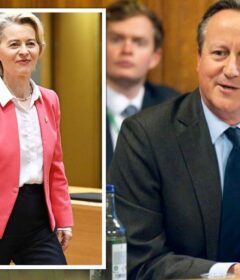Your Top 12 Questions About the Midterms
There is so much coverage out there. So many races and candidates.
But these midterm elections could be a turning point: a reaffirmation of President Trump’s leadership of the Republican Party or a protest against the G.O.P. that doubles as an expression of support for the Democrats.
That’s where our national political correspondent Alex Burns and The Campaign Reporter come in. The Campaign Reporter is a messenger project in which readers regularly receive Alex’s dispatches as he covers some of the most important elections across the United States, from the suburbs of Dallas to Concord, N.H.
Sign up for The Campaign Reporter
Hey, I’m Alex Burns, a politics correspondent for The Times. Send me your questions using the NYT app. I’ll give you the latest intel from the campaign trail.
It is also a place where readers can weigh in on our coverage.
For example, readers of The Campaign Reporter recently voted to send Alex to Georgia for the first debate between the state’s candidates for governor, Stacey Abrams and Brian Kemp (in lieu of attending the debate between Florida’s candidates for governor or events featuring potential presidential candidates).
And every day, between long trips to phone banks at a community center or a debate watch party, Alex answers reader questions. Here’s a selection of some of the most common ones since we started last month.
Are early voting numbers a good indicator of who’s going to win?
A bunch of you are asking about these early voting numbers. …
I’m going to be honest, this is a traumatic subject for me because of 2016.
A lot of tea leaves in the early voting — in Florida especially — looked as if Hillary Clinton were headed for a clear win.
More than other polling, that’s what I feel led me astray two years ago. So I’m very suspicious of early-voting analysis.
Having said that, here are some things you should keep in mind when you read about early voting.
It can definitely be a gauge of enthusiasm. But massive early voting for one party or the other doesn’t necessarily mean more voting over all.
And Republicans and Democrats tend to cast their early votes differently. Republicans like voting by mail, Democrats like voting early in person.
Still, you can learn something about how the parties see the election, where nationalizing a race could be helpful. Barack Obama went to Nevada to boost early voting there. President Trump went to Texas for the same reason.
How does a super PAC “support” candidates?
Here’s how super PACs flex their muscles.
Meredith from Oregon and Andrea from Boca Raton both wanted to know more about super PACs.
The main thing they do is paid advertising, though some also fund get-out-the-vote organizing on the ground.
At this point in the election, you see these hugely well-funded groups shifting money all over the map to drive their side’s message on TV. In most cases, the ads are negative.
That’s because Democratic and Republican strategists believe candidates have to tell their own positive stories. If you see a candidate talking into the camera, that’s almost never a super PAC ad.
So when Senate Majority PAC, a Democratic super PAC, announced that it would spend millions to boost Bob Menendez, a vulnerable New Jersey senator, you could have guessed it would be for attack ads against his Republican opponent, Bob Hugin.
And sure enough, that’s what it has been — ads attacking Hugin as a pro-Trump pharma executive.
You see a TON of late attack ads the last few weeks. These groups have a lot of flexibility to spend money, and they will move it around a lot as they see new points of weakness.
Do TV campaign ads actually work?
Katey from Illinois asked how important TV ads are and whether they sway people.
My unsatisfying answer is: It depends on the ads!
When you watch them, think about what NEW information viewers are learning — and whether it seems believable.
If an ad just says, “Candidate X is great/bad,” it probably matters less. But if you’d never heard of a candidate and the first thing you learn is that they’re a veteran or a teacher, that probably leaves a good impression.
If you’ve heard of a candidate who sounds vaguely nice and then you see an ad that they’ve endorsed cutting Social Security, or they’ve been accused of sexual harassment — well, that changes things.
Most voters do not follow elections nearly as closely as all of you. So general impressions of candidates and political parties really do matter.
Why is the money they’re raising so important?
Good question from Kira in Cornwall (in Britain!) about why the fund-raising numbers are so important. She asked: “Is it not more important to focus on polls?”
For starters, we can do both!
But seriously, the money tells us things that polls can’t.
Over the course of the election, you’ve seen G.O.P. super PACs apply enormous, focused pressure with an onslaught of TV ads in districts with close races.
Had Democrats not amassed these huge war chests with small-donor money, that super PAC onslaught could have overwhelmed them.
The money numbers tell us who’s going to be able to deliver a strong message on TV and online in the final weeks of an election. That’s important when so many races are within the margin of sampling error in the polls.
One thing to know about TV advertising in the United States is that candidates can buy airtime more cheaply than super PACs can. They get preferential rates.
So candidate fund-raising numbers are especially important because candidate money goes further than outside money.
Can I even trust the polling?
A bunch of you have asked about polling and what to trust after 2016.
The short answer is: Trust the big picture. When you see really consistent trends, like women swinging against the G.O.P. or Trump being very popular with Republicans, you can assume that’s reliable.
The polls I trust most, personally, are the ones that line up with actual election results we’ve seen recently. When a poll shows Democrats doing very well in the suburbs of D.C. and Richmond, that makes sense — it’s exactly what happened in Virginia’s 2017 off-year elections.
But you shouldn’t take any one poll as authoritative.
One thing to remember is that political parties and campaigns have a LOT more polling information and other data than we do.
So their strategic choices are backed by a lot more information than the media polling you and I see.
As a campaign reporter, part of what I try to do is get a sense of the private (and very expensive) polling the parties are using. In many cases, private Democratic and Republican polling is pretty similar — though the two sides can draw really different conclusions from the same numbers.
What effect do celebrity endorsements have?
So let’s talk about Taylor Swift!
She endorsed a couple of Democrats, including Phil Bredesen for Senate in Tennessee. Eron from Dallas was wondering if celebrity involvement might make a difference with young people.
I’d be skeptical that it will help Bredesen, who seems to be falling behind and wasn’t really counting on young voters in the first place.
But engagement in the midterms is pretty low over all, especially among young people. In 2014, just 13 percent of voters were under 30.
So if Taylor Swift talking at the A.M.A.s about voting makes people aware that the elections are even happening … that could matter for some people. And it’s probably good for democracy.
How are moderate Republicans doing?
I should really say “relatively moderate” Republicans.
Allison from Syracuse asked about Representative John Katko from central New York, who seems to be in pretty good shape for re-election.
Not many Republicans in the House can be described as moderate, and almost all of them are facing tough re-election fights in their purple suburban districts.
A couple of Republicans have pointed out to me that this is one of the ironies of the election: If Democrats take the House, they’ll do it by beating many Republicans who have been willing, from time to time, to break with Trump.
So the Republican caucus could get Trumpier as it gets smaller and members like Mike Coffman in Colorado and Jeff Denham in California lose.
But Katko’s also a good example, along with Will Hurd of Texas, of where even a decent-size Democratic wave could fall short.
These Republicans have never been able to take re-election for granted, and they’ve worked hard to project an image different from the national G.O.P.’s. Republicans in light-red districts mostly haven’t done that, and they’re more endangered this year as a result.
What about Democratic districts that might flip?
Interesting questions today! Ed from Rochester, Minn., asked about House seats Democrats could lose.
Not a coincidence that this question comes from a Minnesotan: The two Democratic-held seats that are most at risk are both in Minnesota. They are the First and Eighth Districts, where incumbents aren’t running for re-election.
If one of those two flips, it’s probably the Eighth. The First, in southern Minnesota, has a weaker Republican candidate, and the current Democratic member of Congress there, Tim Walz, is running a strong race for governor and will probably lift the whole ticket.
But the G.O.P. is trying to take both of those seats and a couple of others, including Representative Matt Cartwright’s seat in Pennsylvania. But these areas held by Democrats voted for Trump in 2016.
The map is mostly Republicans playing defense, thanks to Trump’s unpopularity. But it’s worth remembering that Democrats need to NET a 23-seat gain, not just win 23 G.O.P.-held seats. So if Republicans win one or both Minnesota districts, Democrats need to make up for it elsewhere.
Is anyone talking about climate change?
Shosh from Chicago asked if the climate will matter in the election. Conventional wisdom and polls say it won’t, but I actually disagree with that.
I think the climate is part of a cluster of issues — including gun control and gun rights — that send a strong cultural signal about what kind of person a candidate is.
You see advertising on climate and the environment in places like California and Minnesota, where voters may not be focused on climate science as such, but where the environment is important to people.
One thing I’m watching is whether the climate becomes an important issue to voters in places stricken by extreme weather, like Florida.
How much are the races dominated by national issues?
Not all the elections are just about Trump.
I would point to a couple of urgent state and local issues, which aren’t as obvious as national themes and are a factor even in some federal elections.
Most of these campaigns are dominated by national issues — Trump, health care, the Supreme Court — but there are exceptions.
One is education funding in states where schools and teachers are in bad shape. I’m sure you remember the teacher strikes and walkouts this year in a number of red states, like West Virginia and Oklahoma.
There are also some environmental issues that resonate more locally than nationally: toxic algae, most importantly in Florida but also in states like Ohio.
And this is kind of a national issue, but there are states where infrastructure — roads and bridges — is just a more urgent concern. I’ve heard a lot of that in the Midwest, and I’m sure many folks have seen candidates talking about that in ads.
Why do high-profile figures make appearances for candidates who are so far behind?
Hello from New Hampshire! I did not dress warmly enough (sorry, Mom).
Bob from Iowa wanted to know who’s testing the presidential waters here. I’m glad you asked!
In a little bit, I’m going to see Kirsten Gillibrand, the New York senator, campaign with Molly Kelly, the Democratic candidate for governor in New Hampshire.
Kelly’s an underdog, but she’s gotten help from a bunch of national Democrats who want to run for president, including Cory Booker.
That’s happening in other early presidential states, too. Joe Biden’s going to South Carolina for James Smith, the Democratic candidate for governor there, even though Smith’s unlikely to win.
But it helps to make friends in these states even if they don’t win. They still have local credibility and networks of supporters to lend out.
And why bother covering those events?
So I’m headed to South Carolina.
Kamala Harris is campaigning for Democrats there. It’s another moment of 2018 melting into 2020.
The point of these trips isn’t just to check out the early stages of the presidential race. (The idea of covering another election season makes me ? just thinking about it.)
They’re also where you can see a party searching for and trying to define its identity.
I spent a lot of time watching the G.O.P. go through this when Obama was president. You see competing themes and visions emerge in the midterms, well before they get sorted out in presidential primaries.
Source: Read Full Article



